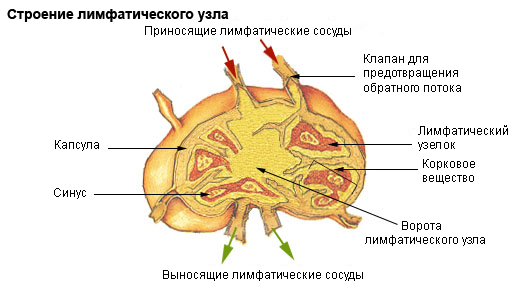The lymph nodes
Last reviewed: 19.11.2021

All iLive content is medically reviewed or fact checked to ensure as much factual accuracy as possible.
We have strict sourcing guidelines and only link to reputable media sites, academic research institutions and, whenever possible, medically peer reviewed studies. Note that the numbers in parentheses ([1], [2], etc.) are clickable links to these studies.
If you feel that any of our content is inaccurate, out-of-date, or otherwise questionable, please select it and press Ctrl + Enter.
Lymph nodes (nodi lymphatici) are usually located near the blood vessels, often near large veins, usually in groups - from a few knots to ten or more. Taking into account the peculiarities of the situation (anatomo-topographic principle), as well as the direction of the lymph current from the organs (the principle of regionality), there are about 150 regional groups of lymph nodes in the human body (from the Latin regio - region, site). Accordingly, the area of location is allocated: lumbar lymph nodes (nodi lymphatici lumbales), axillary lymph nodes (nodi lymphatici axillaris), etc. A group of lymph nodes can be called a blood vessel, next to which it is: celiac lymph nodes (nodi lymphatici coeliaci), iliac lymph nodes (nodi lymphatici iliaci).
In some areas of the human body, groups of lymph nodes are arranged in two layers, one group above the other. Between these groups is usually located fascia. In such cases, the nodes lying on the fascia are called superficial, and those lying under the fascia are deep: for example, the superficial inguinal lymph nodes (nodi lymphatici inguinales superficiales) are located on the wide fascia of the thigh, and under the fascia are the deep inguinal lymph nodes (nodi lymphatici inguinales profundi ).

In the body cavities: thoracic, abdominal, in the pelvic cavity - the lymph nodes lie near the internal organs and on the walls of the cavities. Considering the position of the nodes, the first of them is usually called the visceral (internal) lymph nodes (nodi lymphatici viscerales). These are such groups of lymph nodes as mediastinal, bronchopulmonary, tracheobronchial in the thoracic cavity; near-rectal, intramuscular, periarticular - in the pelvic cavity. The walls of the cavities are parietal (parietal) lymph nodes (nodi lymphatici parietales). These include peri-chest, intercostal, upper diaphragmatic lymph nodes in the thoracic cavity; lumbar, lower epigastric, lower diaphragmatic - in the abdominal cavity; iliac: common, external and internal lymph nodes - in the pelvic cavity.
Lymph nodes are pinkish gray, they are roundish, ovoid, bean-shaped and even ribbon-like, their sizes from a pinhead (0.5-1.0 mm) to a large bean (30-50 mm long and more). Each lymph node is covered on the outside with a connective tissue capsule. Inside the lymph node there are connective tissue (reticular) stroma and parenchyma, represented by lymphoid tissue. There is also a system of channels communicating with each other - lymphatic sinuses, through which lymph flows through the lymph node. Under the capsule there is a subcapsular (marginal) sine, leaving its ends directly to the gates of the node. From it to the parenchyma of the lymph node depart intermediate (at first cortical, and then cerebral) sinuses, in the area of the organ gates they pass into the portal sinus. In this sine opens also the subcapsular sinus.
To the lymph node, lymph enters the lymphatic vessels (vdsa afferentia). These vessels in the amount of 2-4 fit the convex side of the node, perforate the capsule and fall into the subcapsular (marginal) sinus. Then, along this sinus and along the intermediate ones, which are in the parenchyma of the node and communicate with each other, lymph enters the portal sinus. Out of the portal sinus, there are 1-2 enduring lymph vessels (vasa efferentia) through which lymph flows from the lymph node. In the lumen of the sinuses of the medulla there is a fine-meshed network formed by the reticular fibers and the reticular cells. When lymph is passed through the sine system of the lymph node, foreign particles trapped in the lymphatic vessels from the tissues (microbial bodies, dead and tumor cells, dust particles) are trapped in the loops of the network. Lymphocytes enter the lymph from the parenchyma of the lymph node.
According to the endometrial lymphatic vessels, lymph from one of the nodes is directed to the next lymph nodes lying on the path of its current or to the collection vessels - lymphatic trunks and ducts. In each regional group, the lymph nodes are connected to each other by interstitial lymphatic vessels. On these vessels, lymph flows from one node to another in the direction of the general current, toward the venous angle. On its way from each organ of lymph passes through not less than one lymph node, and more often after a few. For example, in the path of lymph flow from the stomach occurs 6-8 knots, from the kidney lymph passes through 6-10 lymph nodes. Only the esophagus is an exception. From the middle part of it, some lymphatic vessels flow directly into a nearby lying chest duct, bypassing the lymph nodes. Therefore, in cancer of the esophagus, tumor cells with lymph reach the thoracic duct, and then into the blood, without passing through the lymph nodes. Individual lymphatic vessels of the liver in rare cases also flow directly into the thoracic duct.
What do need to examine?
How to examine?

